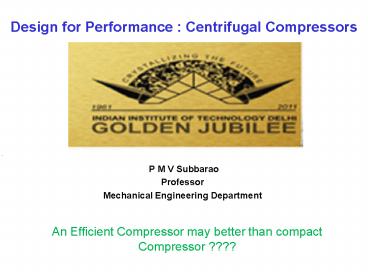Design for Performance : Centrifugal Compressors - PowerPoint PPT Presentation
1 / 14
Title:
Design for Performance : Centrifugal Compressors
Description:
Design for Performance : Centrifugal Compressors P M V Subbarao Professor Mechanical Engineering Department An Efficient Compressor may better than compact Compressor – PowerPoint PPT presentation
Number of Views:529
Avg rating:3.0/5.0
Title: Design for Performance : Centrifugal Compressors
1
Design for Performance Centrifugal Compressors
- P M V Subbarao
- Professor
- Mechanical Engineering Department
An Efficient Compressor may better than compact
Compressor ????
2
Tip Speed Materials
- The precise stress limits of a given impeller
material will depend upon factors such as the
required cyclic duty (number of startstop cycles
per unit time). - Cast aluminium to be used up to a tip speed of
around 200300 m/s, - forged machined aluminium up to where a maximum
of about 500 m/s. - titanium up to around 650700 m/s.
- Titanium aluminides and titanium metal matrix
composites are currently being researched for the
higher tip speeds.
3
The balance of factors affecting stage stability,
derived from the work factor is to limit
impeller stress levels usually results in a
backsweep angle of at least 30
4
Efficiency of A Centrifugal Compressor
- Broadly speaking, two approaches are used for to
determining stage efficiency at the preliminary
design stage. - An approach that at first sight appears to be
less dependent upon empiricism is to formulate a
general 1D compressor model that includes some
system of loss estimation for the principal flow
elements of the stage. - The most comprehensive method includes, models
for IGV, impeller, vaneless space and vaned
diffuser.
The loss models are tuned so that the method
obtains reasonable agreement with a
representative range of test cases.
5
Development of Loss Model
- A best empirical approach is to correlate
efficiency with parameters such as specific speed
or the flow coefficient. - In aero applications, the specific speed is
defined as
and the flow coefficient as
6
Rodgers efficiency versus specific speed
h
7
Impeller Exit Geometry Vs Tip Losses
8
Losses in Stator Passages
9
Irreversible Diffuser
T
s
10
Gas Dynamics of A Real Impeller
Va2
Vr2
Vf2
Vw2 lt U
Vr1
11
(No Transcript)
12
Slip Factor, Power Input Factor Efficiency
- Power input factor and slip factor are neither
independent of one another nor of efficiency. - The power input factor represents an increase in
the work input. - The whole of this increment is absorbed in
overcoming frictional loss and therefore degraded
into thermal energy. - Power input factor should be as close as possible
to unity. - Low values of Power input factor imply that the
impeller is very efficient. - However, the value of compressor efficiency also
depends on friction losses in the diffuser which
does not affect power input factor. - The slip factor limits the capacity of the
compressor and this should be as high as
possible. - A high value of slip factor requires higher
number of vanes. - Higher number vanes will increase frictional
losses and hence increase the value of power
input factor and decrease the value of
efficiency. - A suitable compromise must be found, and present
day practice is - 19 21 vanes to get a slip factor value of 0.9.
- There is high demand for Compact design of a
centrifugal.
13
Optimum design of a centrifugal compressor inlet
- To obtain high efficiencies from high pressure
ratio compressors it is necessary to limit the
relative Mach number at the eye. - The flow area at the eye can be written as
Optimum ratio
Tip velocity of eye
Eye tip
Eye hub
14
With uniform flow velocity the continuity
equation is
Ut1
bt1
at1































